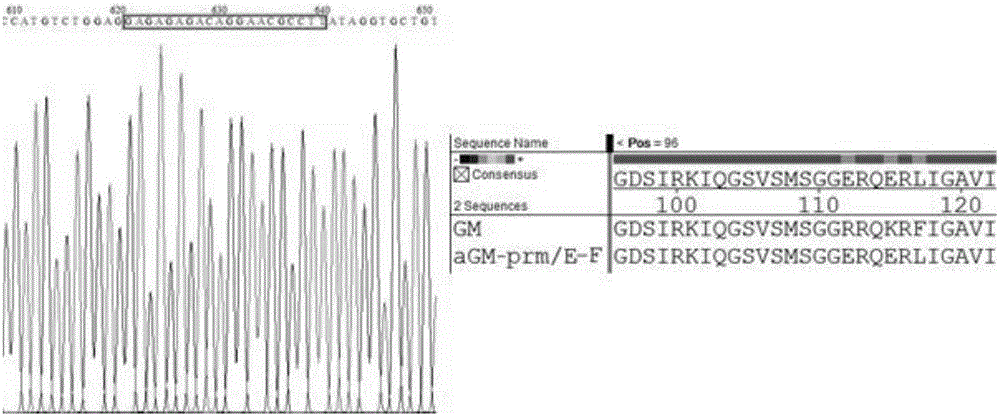Preparation method and application of live vector vaccine for expressing duck Tembusu virus (DTMUV) prm and E protein recombinant Newcastle disease virus (NDV)
A technology of duck Tembusu virus and Newcastle disease virus, which is applied in the preparation and application of live vector vaccines, can solve the problems of strong virulence and low virus titer, and achieve the effect of reducing detoxification
- Summary
- Abstract
- Description
- Claims
- Application Information
AI Technical Summary
Problems solved by technology
Method used
Image
Examples
experiment example 1
[0032] Construction of the full-length plasmid of experimental example 1 attenuated GM strain
[0033] Newcastle disease GM strain (GenBank accession no. DQ486859) full-length cDNA cloning plasmid (TVT-GM) rescued virus is a virulent strain, which has potential biological safety hazards. In order to weaken the virus, this study designed two pairs of primers (see Table 1). After PCR amplification of the TVT-GM plasmid, two mutant fragments were obtained, and then the fragment of the mutant F protein cleavage site sequence was obtained by fusion PCR ( named Fa). After the Fa fragment and the TVT-GM plasmid were digested by Age I and Asc I respectively, the Fa fragment and the fragment of about 14 kb after digestion of the TVT-GM plasmid were recovered, and they were ligated with T4 DNA ligase. The ligation product was transformed into DH5α competent, and the plasmid was extracted by Qiagen QIAprep Spin Miniprep Kit, which was the attenuated full-length plasmid, which was confir...
experiment example 2
[0038] Experimental example 2 Construction of recombinant Newcastle disease virus plasmid expressing duck Tembusu virus prm and E protein
[0039] In order to enable the foreign gene to be successfully inserted into the Newcastle disease virus, on the basis of obtaining the attenuated full-length plasmid TVT-aGM, design the Pme-6200U and Pme-6193L primers (Table 2), and use the upstream primer F1- Mut-U and Pme-6193L primers amplified a 290bp fragment, while Pme-6200U and downstream primer F2-Mut-L were used to amplify a 3629bp fragment. Subsequently, using the recovered product as a template, PCR amplification was performed using F1-Mut-U and F2-Mut-L primers, and the obtained fragment was ligated with the pMD18T vector and named as Fa-Pme. Subsequently, use JM-prm / E-U and JM-prm / E-L primers to amplify duck Tembusu virus JM strain (preservation number is CCTCC NO: V201131) nucleic acid, obtain prm and E gene fragments (GenBankaccession number: JN811559), length It is 2080bp....
experiment example 3
[0043] Identification of Experimental Example 3 Recombinant Virus aGM-prm / E
[0044] The eukaryotic expression plasmids pCI-NP, pCI-P and pCI-L expressing the Newcastle disease virus NP, P and L genes constructed by the pCI-neo plasmid of Promega Company respectively, according to the method of Lipofectamine LTX instructions, the full-length plasmid TVT- aGM and helper plasmids pCI-NP, pCI-P and pCI-L were co-transfected into BSR-T7 / 5 cells converging 90% of the cell plate at a ratio of 2:2:1:1. 24 hours after transfection, TPCK trypsin or 10% SPF chick embryo allantoic fluid was added at a final concentration of 1 μg / μL. After 72 hours of transfection, the cells were repeatedly frozen and thawed three times, and the mixture was inoculated into 9-day-old SPF chicken embryos, 0.5 mL / embryo. The dead embryos within 24 hours were discarded, the allantoic fluid of all dead and surviving chicken embryos were harvested within 24-120 hours, and the HA titers were determined respecti...
PUM
 Login to View More
Login to View More Abstract
Description
Claims
Application Information
 Login to View More
Login to View More - R&D
- Intellectual Property
- Life Sciences
- Materials
- Tech Scout
- Unparalleled Data Quality
- Higher Quality Content
- 60% Fewer Hallucinations
Browse by: Latest US Patents, China's latest patents, Technical Efficacy Thesaurus, Application Domain, Technology Topic, Popular Technical Reports.
© 2025 PatSnap. All rights reserved.Legal|Privacy policy|Modern Slavery Act Transparency Statement|Sitemap|About US| Contact US: help@patsnap.com



